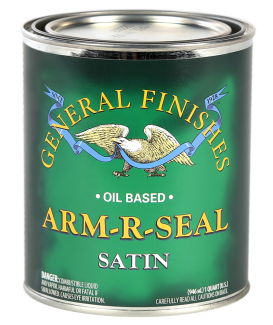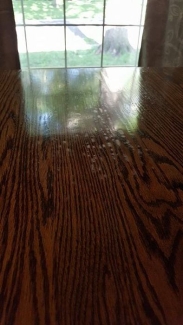

Arm-R-Seal Oil-Based Topcoats are made with the highest-quality urethane resin, making them extremely durable and long-lasting. Formulated to be wiped on with a cloth or applied with a foam brush, this ambering finish penetrates to provide deep-down protection for that "natural" look.
Oil-based topcoats are "oxidizing" products which means that the moment it is introduced to oxygen, a chemical reaction will cause the finish to begin to harden. As topcoat is used, the empty space in the can is filled with air, furthering the curing process.
Tips to ensure your Arm-R-Seal remains in great working condition:
Arm-R-Seal can be sprayed successfully, but we prefer hand application methods because it is very easy to spray too much in one area. If you choose to spray, use very thin coats and watch for runs (large drips that run down the side of your project).
If you notice a run, immediately wipe or brush it out. If you correct a run promptly, you will not see a mark. However, dried runs can be difficult to remove.

Although Arm-R-Seal rarely needs thinning because of its low viscosity, it can be thinned with up to 10% mineral spirits - more than that may thin the solids content too much.
Thinned Arm-R-Seal will be diluted but can be stored without risk of separation.
We know of many customers that have achieved great results from buffing Arm-R-Seal with auto polishes, providing that the finish has cured for 7 to 10 days.
As with all products that are not manufactured by General Finishes, always test for compatibility on a hidden area of your project before getting started.
GF has two products that would work well.
For non-professional finishers, we recommend using General Finishes Arm-R-Seal Topcoat.
Yes! But you must follow ONE simple rule to ensure the best possible finish: the underlying finish must be absolutely dry.

The problem areas on your table are probably caused by surface contamination from oils, waxes or cleaning products used over the years.
Contaminants from dusting sprays that contain silicone will also impact the appearance and adherence of a finish - silicone is almost impossible to remove. Oil soaps and wax can also cause adhesion failures. This may be why the finish is performing differently on the leaves vs the table top. Adhesion failure is often more obvious in the deepest patterns of grain because the contamination is driven deep into the grain.
Yes! But you must follow a few simple rules to be sure you achieve the best possible finish.
An unusual combination of oils, urethanes, and wax, Seal-A-Cell Clear has served craftsman for decades as the best wipe-on clear coat to get that "natural" look on beautiful woods. The oils penetrate deep into the wood to highlight the figure of the wood, and the urethane ensures durability.